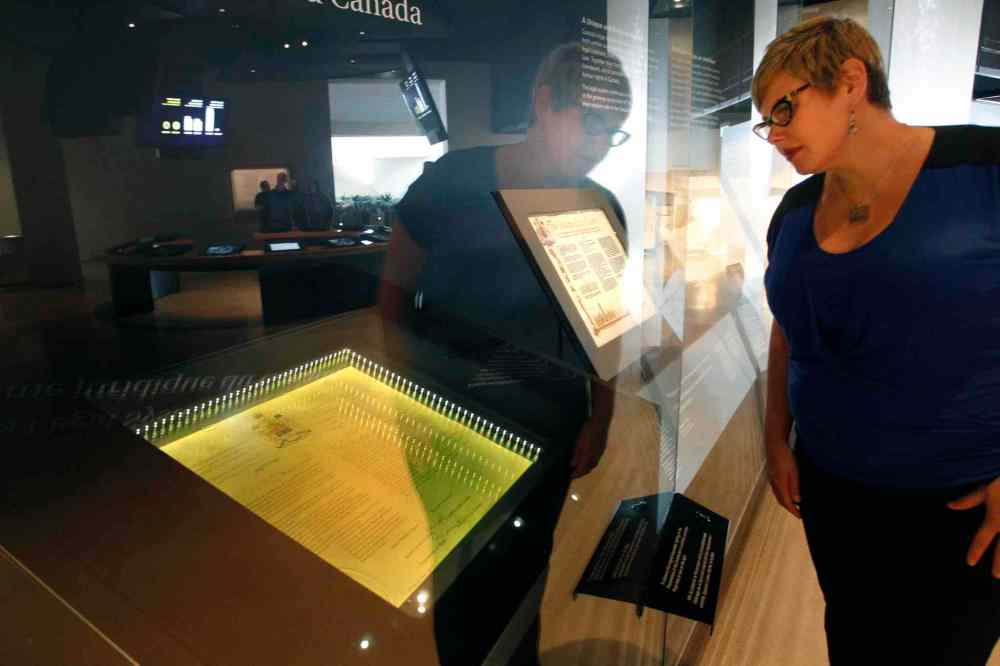Constitution Act, Treaty 1 at CMHR
Documents the basis of Canadians' rights
Advertisement
Read this article for free:
or
Already have an account? Log in here »
To continue reading, please subscribe:
Monthly Digital Subscription
$19 $0 for the first 4 weeks*
- Enjoy unlimited reading on winnipegfreepress.com
- Read the E-Edition, our digital replica newspaper
- Access News Break, our award-winning app
- Play interactive puzzles
*No charge for 4 weeks then billed as $19 every four weeks (new subscribers and qualified returning subscribers only). Cancel anytime.
Read unlimited articles for free today:
or
Already have an account? Log in here »
Hey there, time traveller!
This article was published 17/12/2014 (3409 days ago), so information in it may no longer be current.
The original Treaty No. 1 land agreement of 1871 and the 1982 Proclamation of the Constitution Act are two of 11 historic and rarely loaned artifacts on display at the Canadian Museum for Human Rights.
The documents can be viewed in the CMHR’s Protection Rights in Canada gallery and Canadian Journeys gallery and are on loan until September 2015 from the Library and Archives Canada based in Gatineau, Que. The display has been open to public viewing since the museum’s opening day on Nov. 11.
Signed at Lower Fort Garry by Chippewan and Cree First Nations leaders and Queen Victoria, the Treaty No. 1 agreement is the original document with affixed seals and ribbon.

“Just looking at the display in the case, we’ve got 250 years of Canadian legal tradition and human rights tradition in these documents. There is a really wide breadth of historical significance,” said Heather Bidzinski, the CMHR’s head of collections.
Treaty No. 1 was ratified by seven First Nations chiefs and was the first of 11 numbered treaties still in use today.
“It’s a really important recognition that the Canadian Museum for Human Rights is on Treaty One land and a reminder that agreements were signed to share land and that treaties affect all people, both indigenous and non-indigenous people,” said Jodi Giesbrecht, the CMHR’s manager of research.
“When visitors come through our galleries and they learn about the various rights and freedoms that we have, a lot of those come from the development of these documents.”
The 1982 Proclamation of the Constitution Act, signed by Queen Elizabeth and former prime minister Pierre Elliot Trudeau, is the ceremonial document that formally enacted Canada’s newly patriated constitution and the guarantees in the Canadian Charter of Rights and Freedoms.
“The Proclamation of the Constitution is one of the most important documents in this case and this is only the second time it has been exhibited outside the National Capital Region,” Bidzinski said.
Other important pieces of Canada’s history in the exhibit include: handwritten notes by Roy Romanow from the “Kitchen Accord” (1981); an Indian chief’s medal presented to First Nations leaders to commemorate Treaty Nos. 3 to 8 (1873-1899); the Royal Proclamation of 1763, which first recognized aboriginal land rights; the Canadian Bill of Rights (1960); the Study of La Coutume de Paris (customary law of Paris, 1793-1801); and four certificates relating to the Canadian government’s “head tax” restricting Chinese immigration (1913-1919).
To help protect and preserve the collection, it is displayed inside climate-controlled glass cases.
The Constitution document, marked by raindrops from the outdoor signing on Parliament Hill, is in a case that restricts the amount of light to which the document is exposed. Visitors press a button that activates the light for 20-second intervals.
The case features ‘smart-glass’ technology. Microscopic particles are suspended between layers of glass. When electricity is applied, the particles align to allow light to reach the document for the measured amount of time.
Bidzinski said the document has been viewed for 17 light hours of the allowed 625 light hours.
ashley.prest@freepress.mb.ca
History
Updated on Thursday, December 18, 2014 7:27 AM CST: Adds video, replaces photo


